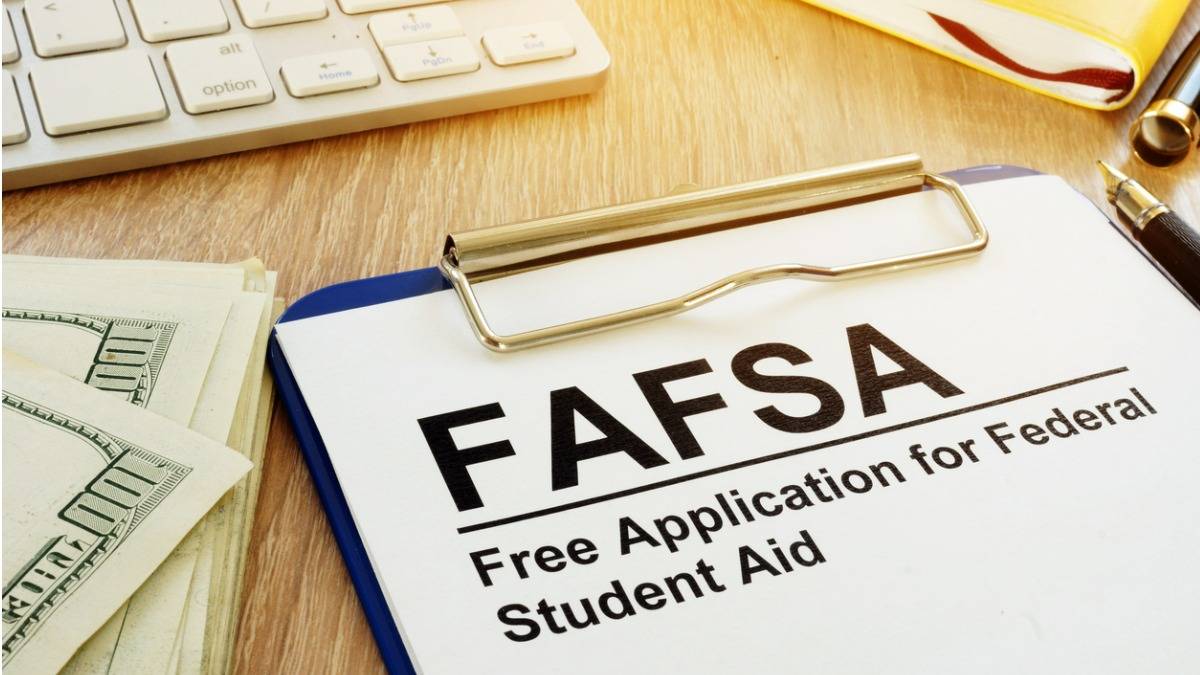

Finance
How To Get A Student Loan Without FAFSA
Published: November 3, 2023
Looking for alternative ways to finance your education? Discover how to secure a student loan without the need for FAFSA, and take control of your financial future.
(Many of the links in this article redirect to a specific reviewed product. Your purchase of these products through affiliate links helps to generate commission for LiveWell, at no extra cost. Learn more)
Table of Contents
- Introduction
- Understanding FAFSA and its Alternatives
- Exploring Private Student Loans
- Researching Scholarships and Grants
- Considering Work-Study Programs
- Seeking Financial Assistance from State or Institutional Sources
- Utilizing Parental Support or Cosigners
- Evaluating Peer-to-Peer Lending Options
- Conclusion
Introduction
Getting a higher education is undoubtedly beneficial, providing opportunities for personal and professional growth. However, the cost of tuition and other expenses can be a major barrier for many individuals, especially when relying solely on traditional financial aid options like the Free Application for Federal Student Aid (FAFSA).
Fortunately, there are alternative methods to secure a student loan without depending on FAFSA. While these options may require additional research and effort, they can help individuals overcome financial obstacles and achieve their educational goals.
In this article, we will explore different strategies for obtaining a student loan without FAFSA. From private loans and scholarships to work-study programs and peer-to-peer lending, we will provide valuable insights and actionable tips to help you navigate the complex world of student financing.
It’s important to note that each alternative comes with its own set of advantages, disadvantages, and eligibility criteria. Therefore, it’s essential to thoroughly assess your options and choose the path that best suits your individual circumstances and aspirations.
So, if you’re ready to explore alternative ways to fund your education without relying solely on FAFSA, read on to discover the various options available to you.
Understanding FAFSA and its Alternatives
FAFSA, or the Free Application for Federal Student Aid, is a widely used application that determines a student’s eligibility for federal financial aid, including grants, work-study programs, and federal student loans. While FAFSA is a common route for students seeking financial assistance, it is not the only option available.
One alternative to FAFSA is private student loans. These loans are provided by banks, credit unions, and online lenders, and can cover the cost of tuition, housing, books, and other educational expenses. Unlike federal loans, private loans often come with higher interest rates and may require a credit check or a cosigner, making them less suitable for students without a strong credit history.
Another option worth exploring is scholarships and grants. Scholarships are typically awarded based on academic achievement, athletic performance, artistic talent, or specific characteristics or affiliations. Grants, on the other hand, are often need-based and provided by individual colleges, states, or private organizations. These forms of financial aid do not need to be repaid, making them an attractive option for students seeking to minimize debt.
Work-study programs are yet another alternative to FAFSA. These programs provide students with part-time employment on or off campus, allowing them to earn money while pursuing their studies. The earnings can be used to cover educational expenses or other personal needs. Work-study programs offer valuable work experience and the opportunity to build skills relevant to the student’s field of study.
State and institutional sources of financial aid can also be explored. Many states offer their own financial aid programs to support local students. Additionally, individual colleges and universities may have specific grants or scholarships available to their students. Researching these opportunities can provide additional funding options beyond what is available through traditional federal aid.
Lastly, parental support or cosigners can play a crucial role in securing a student loan without relying solely on FAFSA. Parents may be able to provide financial assistance through savings or other resources, helping to cover the cost of tuition and other expenses. Alternatively, a cosigner with a strong credit history can improve the likelihood of getting approved for a private student loan.
Understanding FAFSA and its alternatives is essential for students looking to finance their education. By exploring these options, individuals can make informed decisions about their financial future and find the best path to fund their educational pursuits.
Exploring Private Student Loans
If you’re unable to secure a loan through FAFSA or need additional funds to cover your educational expenses, private student loans can be a viable option. Private loans are offered by banks, credit unions, and online lenders, and can help bridge the financial gap.
One of the advantages of private student loans is that they are not restricted by the same guidelines and limitations as federal loans. You can use private loans to cover tuition fees, room and board, textbooks, transportation, and other education-related expenses.
However, before opting for a private student loan, it’s important to carefully consider its terms and conditions. Interest rates for private loans are typically higher than those for federal loans, so it’s crucial to compare different lenders and choose the one with the most favorable interest rates and repayment terms.
In addition to interest rates, it’s important to be aware of repayment options. Private loans may not offer the same flexibility as federal loans, so make sure to understand the repayment schedule and any potential penalties or fees associated with late payments or prepayment.
Another factor to keep in mind is the credit check requirement for private loans. Unlike federal loans, private lenders typically conduct a credit check to assess your creditworthiness. If you have a limited credit history or a low credit score, you may need to apply with a cosigner, such as a parent or guardian, who has a good credit standing.
When exploring private student loans, it’s essential to research and compare different lenders to find the best fit for your needs. Look for reputable lenders that offer competitive interest rates, flexible repayment options, and good customer service. Reading reviews and seeking recommendations from trusted sources can help you make an informed decision.
Remember, private student loans should be considered as a last resort after exhausting all other financial aid options. It’s important to borrow responsibly and only take out the amount necessary to cover your educational expenses. Consider creating a budget and exploring scholarship and grant opportunities to minimize the amount of debt you’ll accrue.
By exploring private student loans as an alternative to FAFSA, you can potentially secure the funds you need to pursue your education while keeping your financial goals in mind.
Researching Scholarships and Grants
When it comes to funding your education without relying on FAFSA, scholarships and grants can be invaluable resources. These forms of financial aid do not need to be repaid, making them an attractive option for students looking to minimize debt.
Start your search for scholarships and grants by exploring opportunities offered by your college or university. Many institutions have their own scholarship programs for students who meet certain criteria, such as academic achievement, extracurricular involvement, or specific majors. Reach out to your school’s financial aid office or visit their website to learn about the scholarships they offer and how to apply.
Additionally, there are numerous scholarship search engines and websites that can help you find external scholarships. Websites like Fastweb, Scholarships.com, and College Board’s Scholarship Search allow you to create a profile and match you with scholarships that align with your background, interests, and academic achievements. These platforms provide a wide range of scholarships from various organizations, foundations, and businesses.
It’s important to keep in mind that scholarship deadlines can vary, so start your search early and pay close attention to application deadlines. Prepare a strong application by carefully reading and following the requirements, instructions, and essay prompts. Put effort into crafting compelling essays that highlight your achievements, aspirations, and how you would benefit from the scholarship.
In addition to scholarships, grants can also provide financial assistance. Grants are often need-based and can be provided by individual colleges, states, or private organizations. Explore grants specific to your state or region, as well as grants offered by professional associations or organizations related to your field of study.
When applying for grants, carefully review the eligibility criteria and application requirements. Some grants may require you to demonstrate financial need or meet specific demographic or academic criteria. Make sure to gather all the necessary documents and meet the deadlines to maximize your chances of receiving a grant.
Don’t limit yourself to just one or two scholarship or grant applications. Cast a wide net and apply to as many opportunities as possible to increase your chances of securing financial aid. Seek advice from your school’s counseling office or financial aid advisors who can provide guidance and support throughout the application process.
By conducting thorough research and diligently applying for scholarships and grants, you can potentially secure funds to help cover your educational expenses without relying solely on FAFSA.
Considering Work-Study Programs
If you’re looking for a way to earn money while pursuing your education, work-study programs can be a great option. Work-study programs provide students with part-time employment on or off campus, allowing them to earn money to help cover their educational expenses.
One of the key benefits of work-study programs is their flexibility. These programs are designed to accommodate students’ schedules, ensuring that work hours do not interfere with class time or academic commitments. This enables students to gain valuable work experience without compromising their studies.
Work-study programs offer various types of job opportunities, including administrative roles, research positions, tutoring, library assistantships, and more. These jobs not only provide income but also allow students to gain skills that can be valuable in their future careers.
To determine eligibility for work-study programs, you need to complete the FAFSA application. The amount of work-study aid you receive will depend on your financial need and the availability of funds at your institution. If you qualify for work-study, your college will provide you with a job placement or assist you in finding employment opportunities.
It’s essential to actively seek work-study opportunities and apply for positions that align with your skills and interests. Reach out to your college’s career center or visit their online job board to explore available positions. Network with professors, advisors, and campus staff who may have information about open positions or can offer recommendations.
When applying for work-study jobs, treat it like any other job application. Prepare a well-crafted resume and cover letter that highlights your relevant skills and experiences. Pay attention to application deadlines and requirements, and submit your application in a timely manner.
Once employed through a work-study program, prioritize your responsibilities and maintain a good work ethic. Communicate effectively with your supervisor, be punctual, and complete assigned tasks with dedication and professionalism.
Participating in a work-study program not only helps you financially but also provides you with practical work experience and an opportunity to develop transferable skills. These experiences can enhance your resume and make you more marketable to future employers.
Remember, work-study programs are competitive, and positions may be limited. Therefore, it’s important to start exploring opportunities early, apply to multiple positions, and maintain a proactive approach to secure a work-study job that suits your needs and interests.
By considering work-study programs as an alternative to FAFSA, you can earn money while pursuing your education, gaining valuable skills, and minimizing your reliance on student loans.
Seeking Financial Assistance from State or Institutional Sources
When it comes to funding your education, it’s worth exploring financial assistance from state or institutional sources beyond what FAFSA provides. Many states offer their own financial aid programs to support local students, while individual colleges and universities often have specific grants or scholarships available.
Start by researching the financial aid options provided by your state. Each state has its own programs, such as need-based grants, scholarships, or loan forgiveness programs. Check your state’s higher education department or website to learn about the different opportunities available to you. Be sure to pay attention to eligibility criteria, application requirements, and the deadlines for these programs.
In addition to state-level programs, individual colleges and universities often have their own financial aid programs. These programs may include scholarships, grants, or tuition waivers specifically for enrolled students. Visit your institution’s financial aid office or website to explore the funding opportunities offered by your college. They can provide valuable information on how to apply and what criteria are required to be considered for these sources of aid.
Furthermore, some institutions may have specific scholarships or grants based on factors like academic achievements, extracurricular involvement, or intended major. Research and apply for these opportunities that align with your qualifications and interests. Reach out to the financial aid office or departmental advisors to inquire about any special funding available to students within your desired field of study.
When applying for state or institutional financial aid, make sure to carefully read and follow the application requirements. Prepare all the necessary documents, such as financial statements, transcripts, essays, or recommendation letters, to complete your application in a timely and accurate manner.
It’s important to note that state and institutional financial aid programs may have limited funding or specific eligibility requirements. Therefore, it’s essential to start your research early and submit your applications well before the deadlines to maximize your chances of receiving financial assistance.
Remember, every source of financial aid helps chip away at the overall cost of your education. By seeking financial assistance from state or institutional sources, you can potentially secure additional funds to supplement your education and reduce your reliance on student loans.
Utilizing Parental Support or Cosigners
When it comes to financing your education without relying solely on FAFSA, one option to consider is utilizing parental support or finding a cosigner. These avenues can help you secure a student loan or increase your chances of approval for private loans.
Parental support can come in various forms. Parents can contribute to your educational expenses by using savings, investments, or other financial resources they have accumulated over the years. This can help reduce the amount of student loans you need to take out or eliminate them altogether.
Additionally, parents can opt to take out a Parent PLUS loan, a federal loan available to parents of dependent undergraduate students. This loan option allows parents to borrow funds on behalf of their child to cover educational expenses. Keep in mind that, as the borrower, your parents will be responsible for loan repayment.
If parental support is not an option, you may consider finding a cosigner to enhance your eligibility for private student loans. A cosigner is someone who guarantees to repay the loan if you are unable to do so. Having a creditworthy cosigner increases your chances of getting approved for a loan and may even help you secure more favorable interest rates.
When seeking a cosigner, consider a family member, such as a parent, grandparent, or sibling, who has good credit history and is willing to assist you. It’s important to discuss the responsibilities and expectations with your cosigner before moving forward. Open and transparent communication is key to maintaining a healthy working relationship.
Remember, both parental support and having a cosigner come with their own financial implications and potential risks. It is crucial to have detailed conversations about expectations, repayment plans, and the long-term impact on both parties involved. It’s also important to explore other financial aid options, such as scholarships, grants, and work-study programs, before considering loans.
Utilizing parental support or finding a cosigner can be helpful in obtaining the necessary funds for your education. However, it’s important to approach these options with careful consideration and ensure that you have a well-thought-out plan for repayment.
By exploring these avenues, you can potentially secure the financial assistance needed to pursue your educational goals while minimizing the burden of student loans.
Evaluating Peer-to-Peer Lending Options
When exploring alternative ways to secure a student loan without FAFSA, one option to consider is peer-to-peer lending. Peer-to-peer lending platforms connect borrowers directly with individual investors who are willing to lend money. This can be an attractive option for students who may not meet the criteria of traditional lenders.
Peer-to-peer lending offers several advantages. First, the application process is typically straightforward and can be completed online. Borrowers create a profile and provide information about their educational background, financial situation, and loan requirements. Investors then evaluate loan requests and decide whether to fund them.
One of the key benefits of peer-to-peer lending is the potential for more competitive interest rates. Since borrowers are connecting directly with individual lenders, there may be more flexibility in negotiating loan terms and interest rates compared to traditional financial institutions. This can lead to more favorable borrowing conditions for students.
However, it’s essential to carefully evaluate the terms and conditions of peer-to-peer loans. Interest rates can vary depending on the individual lender’s assessment of the borrower’s creditworthiness. Additionally, some platforms may charge origination fees or other associated costs, so be sure to understand and factor in these expenses when comparing loan options.
Before committing to a peer-to-peer loan, it’s important to research the lending platform and assess its credibility and reputation. Look for reviews, testimonials, and ratings to ensure that the platform is trustworthy and has a positive track record of connecting borrowers with reliable lenders.
When applying for peer-to-peer loans, be prepared to provide supporting documentation and information to increase your chances of approval. This may include proof of enrollment, academic transcripts, income details, and any other relevant documentation that demonstrates your ability to repay the loan.
Remember, peer-to-peer lending is not like traditional student loans, and repayment terms may differ. Make sure to understand the repayment schedule, including the length of the loan and any penalties or fees associated with late payments. Being responsible and prompt with your loan repayments is crucial for maintaining a positive relationship with the lender.
Peer-to-peer lending can be a viable option for students seeking financial assistance without relying solely on FAFSA. However, like any type of loan, it’s important to evaluate the terms, compare different options, and borrow responsibly. Explore other financial aid alternatives and consider your long-term financial goals before committing to a peer-to-peer loan.
By carefully evaluating peer-to-peer lending options, you may find a borrowing solution that meets your needs and helps you fund your education.
Conclusion
Securing a student loan without solely relying on FAFSA is possible, thanks to various alternative options available to students. By exploring private student loans, researching scholarships and grants, considering work-study programs, seeking financial assistance from state or institutional sources, utilizing parental support or cosigners, and evaluating peer-to-peer lending options, students can find the financial resources they need to pursue their educational dreams.
Private student loans can fill the gap in financing education but should be carefully reviewed and compared to ensure favorable terms and interest rates. Scholarships and grants can provide financial aid without the need for repayment, making them an attractive option for minimizing debt. Work-study programs help students earn money while studying, gaining valuable experience and reducing the need for loans.
State and institutional sources often offer financial assistance specifically tailored to local students or those attending a particular college or university. Parental support or finding a cosigner can enhance eligibility for loans and improve rates and terms. Lastly, peer-to-peer lending platforms connect borrowers with individual lenders, potentially offering competitive interest rates and flexibility in loan terms.
When exploring these alternatives, it’s essential to conduct thorough research, compare options, and be mindful of repayment responsibilities. Creating a budget, applying for multiple scholarships and grants, and seeking guidance from financial aid advisors can increase the chances of success in obtaining financial aid.
Remember, each individual’s financial situation is unique, and it’s crucial to make informed decisions based on personal circumstances and future goals. Minimizing debt and maintaining a responsible approach to financing education should always be a priority.
By exploring these alternative ways of funding education without solely relying on FAFSA, students can take control of their financial future and pursue their educational aspirations with confidence.














